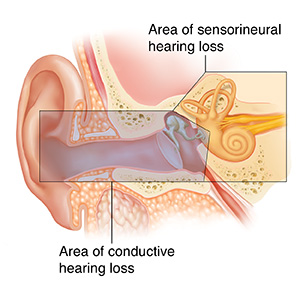Common Middle Ear Problems
Middle ear problems may be caused by something that occurs at birth or right after birth (congenital). This may be an inherited condition. Or it may be due to medicines or to a viral infection such as hepatitis, HIV, syphilis, or cytomegalovirus. Over time, certain growths or bone disease can also harm the middle ear. Left untreated, middle ear problems often lead to lifelong (permanent) hearing loss.
The ear has three main parts: the outer ear, middle ear, and inner ear. The middle ear is made up of:
There are three types of hearing loss:
-
Conductive hearing loss. This is caused by anything that limits outside sound from getting into the inner ear.
-
Sensorineural hearing loss. This type affects the inner ear (cochlea) or the auditory nerve.
-
Mixed hearing loss. This is a combination of conductive and sensorineural hearing loss.

Injury, infection, certain growths, or bone disease can cause your symptoms. A ruptured eardrum or a long-lasting (chronic) ear infection may be painful and decrease hearing.
Symptoms
-
Hearing loss in one or both ears
-
Fluid, often smelly, draining from the ear
-
Mild pain or pressure in the ear
-
Ringing in the ear
Types of hearing loss
Conductive hearing loss
Sound waves may be disrupted before they get to the inner ear. If this happens, you may have conductive hearing loss. Loud sounds may be muffled. And it can be hard to hear soft sounds.
Causes can include:
-
Fluid in the middle ear
-
Ear infection (otitis media)
-
Infection in the ear canal (swimmer’s ear or external otitis)
-
Earwax in the ear canal
-
Noncancer (benign) tumors blocking the outer or middle ear
-
A hole in your eardrum (perforated eardrum)
-
Something stuck in the outer ear
-
Structural problem in the outer or middle ear
This type of hearing loss can often be treated with medicine or surgery.
Sensorineural hearing loss
This is the most common type of lifelong hearing loss. It occurs after damage to the inner ear. It can also occur when there are problems with the nerves that travel from the inner ear to the brain. You may find it hard to hear soft sounds. Louder sounds may not be clear. Or they may be muffled.
Causes can include:
-
Illnesses
-
Certain medicines that damage the ear
-
Age-related hearing loss (presbycusis)
-
Family history of hearing loss
-
Head injury
-
Loud noise exposure
-
Structural problem in the inner ear
In some cases, it may be hard to know the cause of sensorineural hearing loss. Some metabolic disorders, such as diabetes, have been linked to it. If your hearing loss is unexplained, you may need tests to help find the cause. These can include:
In most cases, a sensorineural hearing loss can’t be fixed with medicine or surgery. Hearing aids may be needed.
Mixed hearing loss
This type occurs when a conductive hearing loss happens at the same time as a sensorineural hearing loss. It is a problem in your outer or middle ear and in your inner ear. You may not hear as well in one or both ears.
Treatment for mixed hearing loss may be a combination of medicine or surgery, as well as hearing aids.